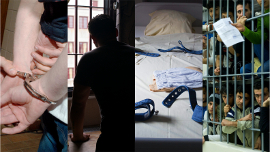The report highlights that a significant number of allegations of physical ill-treatment of criminal suspects by police officers were received in the course of the visit. The allegations concerned primarily slaps, punches, truncheon blows, prolonged handcuffing in stressed positions but also acts which could amount to torture such as the placing of plastic bags over the head of suspects to induce a sensation of suffocation and blows to the soles of the feet with non-standard objects such as wooden floor-tiles (so-called falaka). Recommendations are made to the Serbian authorities to adopt a multi-faceted approach to end ill-treatment by police officials, including the establishment of an effective independent system of complaints against police misconduct. Further, the report notes that there has been no progress as regards the practical implementation of formal safeguards against ill-treatment, notably the right of notification of custody and the quality of assistance provided by ex officio lawyers.
In their response, the Ministry of Interior rejects the allegations of ill-treatment by police officers and describe the functioning of the system of accountability of law enforcement officials for police misconduct.
As regards prisons, the CPT’s delegation received numerous allegations of physical ill-treatment of inmates by staff including at Valjevo Juvenile Correctional Institution. These consisted primarily of slaps, punches and blows with truncheons. Further, inter-prisoner violence and intimidation was a frequent occurrence in particular at Sremska Mitrovica Correctional Institution and Pančevo District Prison. This phenomenon was fuelled by a number of factors such as chronic understaffing, illicit drug use, poor material conditions and a lack of activities. The CPT makes a series of recommendations to address these issues. It also recommends that medical examinations of prisoners be confidential, injuries be accurately recorded.
Material conditions of detention were found to be particularly poor in most of the prisons visited, including unacceptable hygienic conditions and dilapidated infrastructure. The situation was further aggravated by the serious levels of overcrowding; for example, at Pančevo District Prison, six inmates were being accommodated in cells measuring only 8 m2. In the CPT’s view, the conditions of detention at the “Hospital” and “Odmaralište” buildings of Sremska Mitrovica Correctional Institution as well as in the closed sections of Pančevo District Prison could well amount to inhuman and degrading treatment. Recommendations are made to the Serbian authorities to take immediate steps to remedy the situation by reducing occupancy levels and carrying out extensive refurbishments of the prisons visited. Once again, the CPT found that remand prisoners were still not being offered any purposeful activities and could spend more than 23 hours per day locked in their cells. The Committee calls upon the Serbian authorities to offer remand prisoners out-of-cell activities and to ensure that they are offered at least two hours of outdoor exercise per day. Recommendations are also put forward to reinforce the number of health-care staff, notably at Sremska Mitrovica Correctional Institution, to improve psychiatric care for inmates and to review the placement and treatment of inmates, including juveniles, subject to enforced supervision measures.
In the Ministry of Justice’s response, information is provided on the implementation of measures adopted to combat prison overcrowding, the refurbishment and sanitation of the relevant sections of the prisons visited, the planned construction of new prisons, improved training possibilities for prison staff, the increase in health-care personnel and the purchase of medical equipment, in line with the recommendations made by the CPT.
In relation to psychiatric establishments, the CPT’s delegation found that there was a generally caring attitude by staff towards patients at the Special Hospital for Psychiatric Diseases “Dr Slavoljub Bakalović” in Vršac. However, some allegations of physical ill-treatment of patients by staff consisting of slaps and verbal abuse were received. Further, inter-patient violence was serious problem which was mainly linked to the understaffing levels at the establishment. The report is also critical of the lack of an individual approach towards the treatment of patients, and the Committee puts forward recommendations to limit the recourse to the application of means of mechanical restraint and seclusion of patients.
The Ministry of Health had not yet provided a response to the Committee’s recommendations.
The report is critical of the treatment of residents at the Veternik Residential Facility. A few allegations of physical ill-treatment of resident by staff, consisting mainly of slaps were received and inter-resident violence was frequent, related in part to low staffing levels. Further, the report describes the situation of a group of patients who were subject to periods of prolonged mechanical fixation and seclusion. Reference is also made to the widespread recourse to psychoactive medication for residents who did not suffer from a mental health disorder; the CPT recommends that an external independent body conduct a review on the use of chemical restraint in the establishment. The report describes the poor material conditions and overcrowding in some wards (where some residents were being forced to share the same bed) and the necessity to enlarge the range therapeutic and occupational activities for residents. The fundamental safeguards surrounding the placement of residents need to be reinforced.
In their response, the Serbian authorities refer to a number of measures being taken to address the CPT’s recommendations.
The main findings of the CPT are set out in the Executive Summary of the report. The CPT’s visit report and the response of the Serbian Government, which have been published at the request of the Serbian authorities, are available in English on: www.cpt.coe.int.



